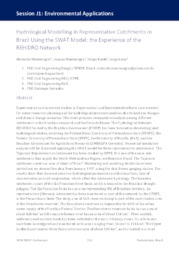Hydrological modelling in representative catchments in Brazil using the SWAT model: the experience of the REHIDRO network.
Hydrological modelling in representative catchments in Brazil using the SWAT model: the experience of the REHIDRO network.
Author(s): MONTENEGRO, A.; MONTENEGRO, S.; KOIDE, S.; LIMA, J. E. F. W.
Summary: Experimental and numerical studies in Experimental and Representative Basins are essential for water resources planning and for hydrological processes analysis due to land use changes and climate change scenarios. This work presents comparative analysis among diferente catchments in the Brazilian semiarid, and the Cerrado Biome. The Hydrological Network REHIDRO funded by the Brazilian Government (FINEP) has been focused on developing joint hydrological studies, involving the Federal Rural University of Pernambuco State (UFRPE), the Federal University of Pernambuco State (UFPE), the University of Brasília (UnB), and the Brazilian Corporation for Agricultural Research (EMBRAPA Cerrados). Numerical simulation analysis will be discussed, applying the SWAT model for three representative catchments: The Tapacurá Representative Catchment has been studied by UFPE. It is one of the main sub- catchments that supply the Recife Metropolitan Region, northeastern Brazil. The Tapacurá catchment covers an area of about 470 km2. Monitoring and modeling studies have been carried out on stream flow data from January 1997, using the data from a gauging station. The results show that the most sensitive hydrological parameters are the base flow, time of concentration and soil evaporation, which affect the catchment hydrology. The Ipanema catchment is part of the São Francisco River basin, and it is located in the Brazilian drought polygon. The São Francisco Basin has an area representing 8% of Brazilian territory. Na representative (Mimoso) catchment has been monitored as part of the network by the UFRPE, in the Pernambuco State. The study area of UnB research Group is part of the contribution área of the Descoberto reservoir. The Descoberto reservoir is responsible for 63% of the urban water supply of the Brazilian Federal District. The Descoberto reservoir basin has an area of about 420 km2 and the main tributary river has an area of about 114 km2. Flow, rainfall, sediments and nutrient loads has been collected at the main tributary rivers. Six sub-basins have been investigated and monitored, with areas ranging from 16 km2 to 114 km2. The Upper Jardim Experimental River Basin covers an area of about 105 km2, and is located in a rural zone of the Federal District, Brazil, in the core region of the Cerrado biome (Brazilian savanna). Since 2001, in order to generate a database to support hydrological studies in a typical rural catchment of the Brazilian savanna, EMBRAPA Cerrados (Savannas Agricultural Research Center), in partnership with the University of Brasilia (UNB), and other institutions, has intensively characterized and monitored this area. Comparative hydrology is discussed, mainly addressing SWAT parameters sensitivity analysis.
Publication year: 2014
Types of publication: Abstract in annals or event proceedings
Unit: Embrapa Cerrados
Keywords: Cerrado soils, Climate change, Hydrology, Savannas, Semiarid zones
Observation
Some of Embrapa's publications are published as ePub files. To read them, use or download one of the following free software options to your computer or mobile device. Android: Google Play Books; IOS: iBooks; Windows and Linux: Calibre.
Access other publications
Access the Agricultural Research Database (BDPA) to consult Embrapa's full library collection and records.
Visit Embrapa Bookstore to purchase books and other publications sold by Embrapa.

